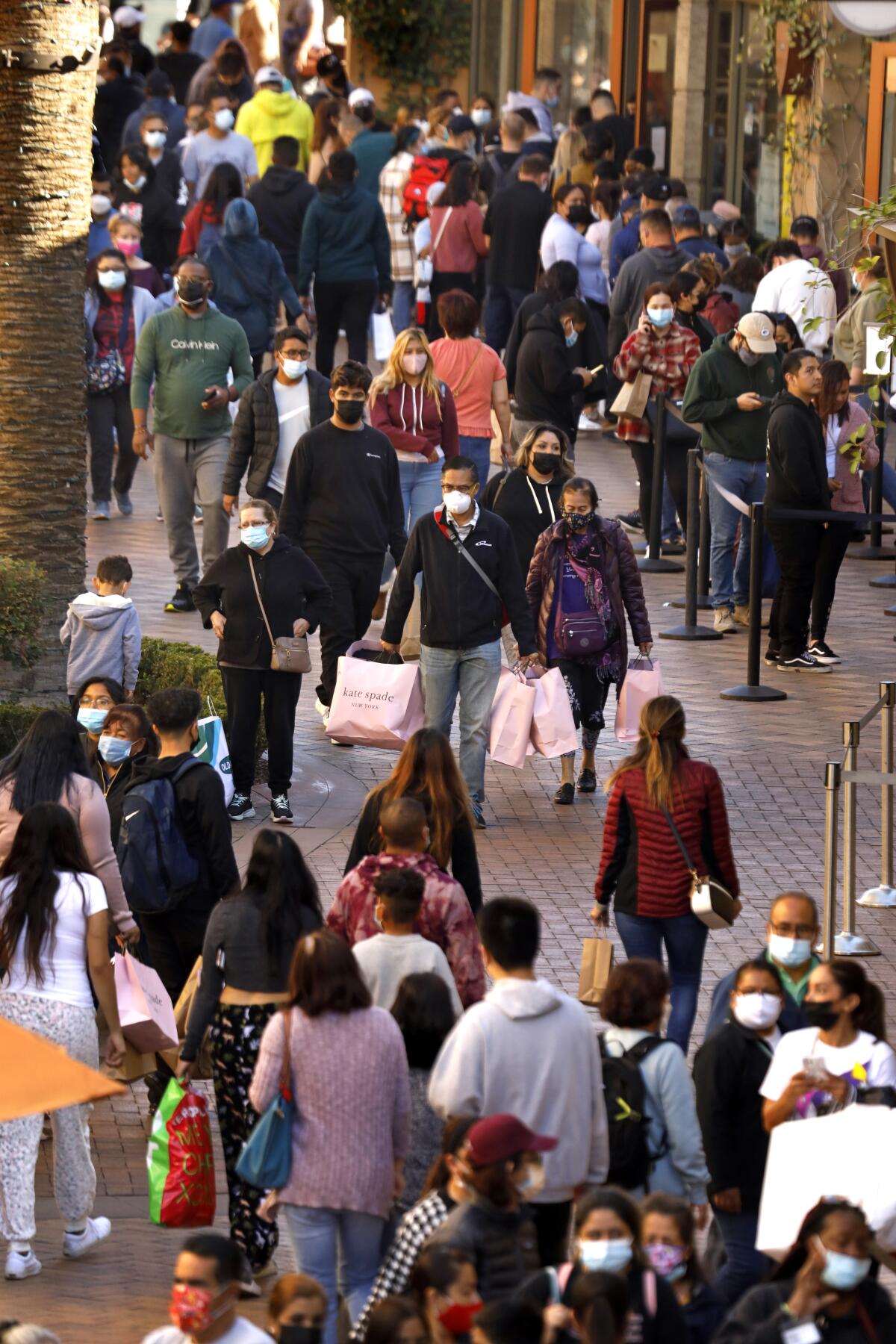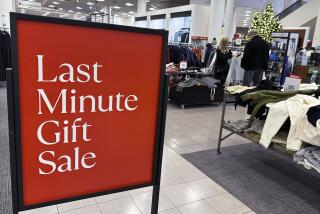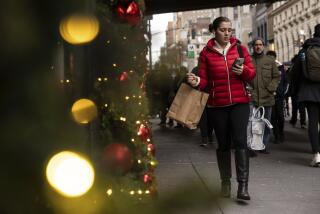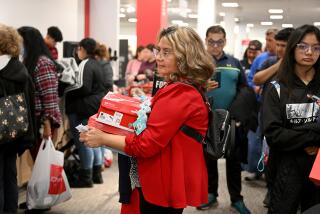Black Friday lacks luster as pandemic shopping habits stick

Ashton Caudillo headed out with his father early Friday morning to the Westfield Santa Anita in Arcadia looking for a hard-to-find PlayStation 5 well before the mall’s 7 a.m. opening. What they found surprised them: only a handful of other shoppers.
The 20-year-old’s father, Lawrence, has a distinct memory of Black Fridays past, when hordes of people made the experience less than pleasant, so he wasn’t complaining.
“Black Friday used to be like Disneyland, waiting in line 45 minutes to spend money. I’d rather shoot myself in the foot than do that. So this, this is nice,” the elder Caudillo said with a smile. “I love when there’s not a lot of people around.”
In the most consumption-oriented nation on Earth, Black Friday in the U.S. has long been viewed as the ultimate looking glass, reflecting all that is good, bad and so-so about the world’s largest economy.
This year the message seems to be: Black Friday is not what it was. A series of factors came together to change how Americans shop: A historic shift to earlier holiday shopping and online sales, the lingering pandemic, uncertainty around a long-brewing supply chain crisis and rising prices.
Around Los Angeles County, foot traffic at malls and stores that have long readied for the consumer assault of Black Friday appeared relatively slow for the biggest shopping day of the year — consistent with reports from elsewhere in the nation.
“It seems very much the key driver is that you have a lot of early spending,” said Vivek Pandya, lead analyst at Adobe Digital Insights, who noted that Thanksgiving Day shopping online also came in at the low end of projections at $5.1 billion.
In-store shopping may have also been hampered this year by supply chain bottlenecks that have led to short supplies of merchandise, with many goods out of stock and some customers opting to sit it out. And the biggest draw of the day — discounts — was largely disappointing as inflation, at a 30-year high, constrained deals.
“The sales are horrible. It doesn’t feel like Black Friday,” said Shelby Coleman, who was shopping at the Del Amo Fashion Center in Torrance with two friends Friday morning.
Accustomed to leaving the mall with shopping bags hanging from each arm, she and her friends left empty-handed.
Fewer than 15 people stood in line at Baldwin Hills Crenshaw Plaza an hour before its 10 a.m. opening, with entire rows of the two-story parking lot still empty when doors swung wide.
Crowds were also smaller than usual early Friday morning outside the Best Buy at the Burbank Empire Center. Foot traffic was similarly light in the morning outside the JCPenney at the Glendale Galleria, though mall traffic picked up substantially later at the major Black Friday destination.
“We’re honestly pretty stunned to see such a minimal turnout. We definitely expected a lot more people to be here that early,” said Elin Markarian, 18, who joined two friends to wait outside the Burbank mall’s Best Buy for four hours before it opened. “We realized we really didn’t need to have gone as early as we did.”
They ended up second in a line of fewer than 100 people, barely enough to wrap around the corner of the store.
In Arcadia, business picked up at the Westfield after opening hours, but it wasn’t the door-busting experience mall workers expected. That was a welcome surprise for Hot Topic sales associate Michele Uribe, who said the day felt “like a regular mall day.”
“I work at a grocery store and I just got over working our busiest day of the year,” she said. “This is a little break from being in the crowds.”
The National Retail Federation is projecting total holiday retail sales will grow between 8.5% and 10.5% from the same period last year — enough to possibly break all-time records — but the figures represent sales in the two full months of November and December.
That reflects the wider window for prime holiday shopping that has emerged since the pandemic. Traditionally, seasonal shopping begins in earnest with Black Friday, but with COVID-19 closing stores last year and retailers introducing online bargains earlier, that rush now starts weeks earlier.
Online shopping was up 19.8% from Nov. 1 through Nov. 23, compared with a year earlier, according to the Adobe Digital Economy Index. For the full holiday shopping season, counted as November and December, internet sales are expected to grow 10% from last year to a record $207 billion.
The growth has contributed to a hybrid shopping experience. Though crowds outside the Galleria’s JCPenney store were light when it opened at 5 a.m., workers inside had been busy preparing online orders for pickup.
Between Wednesday, when the chain’s Black Friday deals dropped, and Friday, the location received pickup orders in the “high hundreds,” said store general manager Brett Wolever. Staff members worked from 1 a.m. getting orders ready.
The lingering pandemic hasn’t helped. The coronavirus’ Delta variant and vaccination resistance also raised health risks for wary shoppers. News of a new variant that appeared to be spreading around the globe fueled some reluctance to head into stores.
At the Glendale Galleria, the dressing rooms of teen retailer Q Fashion were closed to shoppers on Black Friday, a continuation of COVID safety practices the store has implemented for months. Other major clothing brands such as American Eagle also had closed their fitting rooms, though they cited high Black Friday traffic that would slow down shopping.
Those who ventured out early Friday craved a sense of how things used to be. Many said they were happy to be out from behind their computers.
“It’s kind of a return to normalcy for us,” said Christina Perez, in line outside Target at the West Valley Mall in the San Joaquin County city of Tracy. At 6:45 a.m., about 40 people stood awaiting the store’s 7 a.m. opening. “We couldn’t do it the last two years. We just love the interaction.”
At the Citadel Outlets, there was a steady flow of customers at the premium discount shops that are the mall’s draw. Some high-end stores, including Coach, drew long lines.
Phoebe Torres, 28, from Carson, who started shopping at 10 a.m. with her family, was pleased with 50% to 60% markdowns and before noon was carrying bags within bags. After shopping online last year, she was glad to be back: “I missed shopping in person, and there are better deals in the stores than online.”
Big retailers such as Walmart and Target reported they were well stocked for Black Friday and the rest of the shopping season, but smaller retailers without the heft to charter entire ocean freighters are not doing as well.
Though there are signs the bottleneck in international trade is starting to ease, the supply chain backlog will take time to work through, and experts don’t expect a full return to normalcy until next year.
“I think this is going to be the first year with a severe back order,” said Luis Lainez, manager of a T-Mobile store at the West Hollywood Gateway.
Of course, the supply shortage is not only a brick-and-mortar disappointment. Online out-of-stock messages have been rising this month and are up 261% compared with November 2019, according to Adobe.
Another chief impediment for retailers and shoppers: a shrinking number of people willing to work in an industry where long hours standing on your feet, dealing with often short-tempered customers, is a given — an experience ratcheted up to 10 on Black Friday.
Workers across industries, but especially in demanding jobs including retail and restaurants, have taken stock during the pandemic. With new perspective on life and work, some left their jobs, and many retired early.
Others, empowered by an energized labor movement, forced wage hikes from their employers. And still, many retail jobs remain unfilled, leaving some stores in a precarious situation for the holiday shopping season.
The Glendale Galleria opened Friday two hours later than last year, at 9 a.m., at least partly because of a shortage of workers, management said.
“People have found various ways to survive, and that includes relying on other family members, dramatically reducing costs, working in the gig economy, picking up spare jobs here and there,” said Kent Wong, director of the UCLA Labor Center. “It means that workers can be a little choosier with regard to what jobs they want to take.”
A Reddit forum popular among people who quit their jobs was calling on its 1 million members to boycott Amazon on Black Friday to express their displeasure with the company, though there were no signs of a mass boycott or rallies at Amazon facilities.
Not working, however, is not a luxury enjoyed by all, and some employees braced themselves for the year’s busiest shopping day. A string of recent robberies at high-end stores in Northern and Southern California also had retail workers on edge.
“When you have so many people coming in stealing, you began to worry less about those with masks on or not because you are trying to keep an eye out to make sure they aren’t in there to steal,” said Jeffrey Keller, who’s worked at North Hollywood’s Big Lots for the last two months. Keller has also worried about his health on the job.
Kevin Kang, 35, a sales employee at a Verizon store in Koreatown Plaza, was experiencing his first holiday shopping rush. Last year, he was laid off from his job as a sushi chef at a restaurant on Vermont Avenue. After a month at home, he landed the job.
His store at the Koreatown mall on Western Avenue was running a promo on Thursday and Friday giving buyers $800 in credit if they trade in their used phones.
Kang said he would rather be at home playing video games with his 10-year-old son.
“I just want to rest,” he said.
Times staff writers Ashlea Brown, Kenan Draughorne, Jason Sanchez and Jonah Valdez contributed to this report.
More to Read
Inside the business of entertainment
The Wide Shot brings you news, analysis and insights on everything from streaming wars to production — and what it all means for the future.
You may occasionally receive promotional content from the Los Angeles Times.















